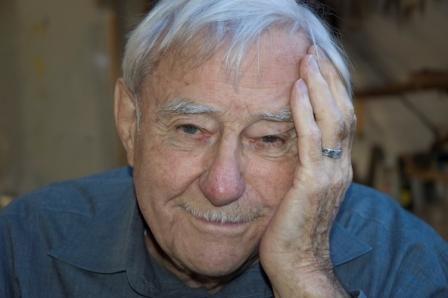

|

|
IN MEMORIAM
Karl Kasten
Professor of Art Practice, Emeritus
UC Berkeley
1916 – 2010
Acclaimed painter and printmaker Karl Kasten, a professor emeritus in the University of California, Berkeley’s Department of Art Practice and a leading figure in “The Berkeley School” of abstract expressionism, died at his Berkeley home on May 3, 2010, at the age of 94. He had suffered from pulmonary fibrosis.
Kasten’s art was exhibited around the world at major public and private museums, including San Francisco’s M. H. de Young Memorial Museum and California Palace of the Legion of Honor; the Art Institute of Chicago; the Musée des Beaux-Arts in Rennes, France; the Galerie Sho in Tokyo; the Whitney Museum of Art in New York City; the Victoria and Albert Museum in London; the São Paolo Bicentennial; and the World Print III traveling show.
Kasten designed and built UC Berkeley’s first printmaking facility. Also, working in 1960 with a manufacturer, the Berglin Corporation, he devised a lightweight, portable press known as the KB press that is still used today in schools and studios around the world. His method of using vacuum-formed plastic plates with insertable parts that allowed the creation of multicolored images in a single press run was considered revolutionary.
Kasten’s work focused on abstract expressionist work and large-scale geometric paintings in the period from 1954 to 1987, but he is also known for his graphics and collographs, prints characterized by rich textural surfaces and often using coins and found objects. Kasten was convinced that printmaking could equal traditional painting through creative exploration.
Born on March 5, 1916, in San Francisco, Kasten recalled in a 2002 interview with the San Francisco Chronicle that his interest in art began at an early age. He said his sixth-grade teacher sent him home with a note to his father. “Dear Mr. Kasten,” it read. “Do something about your son. All he wants to do is draw.” Kasten remembered his father’s response: “Let him draw.”
Kasten later attended the College of Marin and transferred to UC Berkeley, where he became a teaching assistant for artist and mentor Worth Ryder, considered the father of the Berkeley School, which focused on line quality and color flow and dominated American art from the late forties on.
As an undergraduate, Kasten was art editor for the Daily Californian and drew football cartoons for the student newspaper. He earned his B.A. in art from UC Berkeley, and his M.A. in art from UC Berkeley in 1939, the same year he designed card stunts for the Cal Bears’ winning Rose Bowl game with Alabama’s Crimson Tide.
Kasten also studied modern etching techniques and printmaking at the University of Iowa under the G.I. Bill and attended the California School of Fine Art.
When World War II broke out, Kasten went into the Army Medical Corps and became a captain and intelligence officer with the Corps of Engineers. In 1996, he was awarded a medal for his wartime service in France.
Kasten taught at the California School of Fine Arts in 1942, at the University of Michigan from 1946 to 1947, and at San Francisco State University from 1947 to 1950. When Worth Ryder asked him in 1950, for the third time, to join the UC Berkeley faculty, he agreed.
Kasten experimented with cubism and nonobjective painting, but turned to abstract expressionism after attending the Hans Hofmann School of Art in Provincetown, Massachusetts, in 1951.
“We ceased to be provincial,” Kasten said in the 2002 Chronicle interview. “Everybody got into it. It was sort of a mass movement. It was a great period to work in. Just letting things flow and seeing what happens.”
Kasten invited abstract expressionist Willem de Kooning of New York to explore printmaking ideas at UC Berkeley’s print studio. Using a large lithograph press, de Kooning produced a lithograph titled “Waves” that now belongs to UC Berkeley’s Berkeley Art Museum. It was exhibited as part of a campus tribute to Kasten in 2008. De Kooning, who had never made prints with a printing press before, also made one other lithograph while on campus.
In addition to introducing the campus’s printmaking operation, Kasten launched a course at UC Berkeley in new materials and methods that was designed to challenge students’ ideas of how artwork is constructed and executed.
Kasten received numerous awards for his watercolor and oil paintings as well as his graphics, including the Purchase Prize in Graphics at the Fourth Annual Art Festival in San Francisco in 1977. In 1997, he received the Distinguished Artist Award of the California Society of Printmakers. He is also a recipient of a Humanities Research Fellowship and the Tamarind Lithography Fellowship.
Kasten told a Daily Californian reporter in 1977 that an artist’s life presents its own opportunities and risks. “The artist in our society is free to do pretty much what he pleases,” Kasten said. “But he does it at his own expense. There is no guarantee that anyone else is going to appreciate his work. But there is always the chance that he may hit the magical thing that will really turn people on.”
Kasten taught at UC Berkeley until 1983. He remained active in art almost up until his death, working in the attic studio in his home in the Berkeley hills and writing his memoir, Foghorns & Peacocks: a Memoir, published in 2009.
Kasten is survived by his wife of 52 years, Georgette Kasten; two daughters, Beatrix Kasten and Cho-An Kasten Buckley, both of Oakland, California; two sons, Ross Kasten of Sacramento, California, and Lee Kasten of Daly City, California; and five grandchildren.
Kathleen Maclay 2010
Media Relations